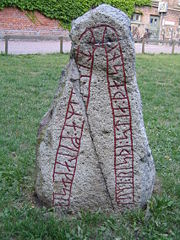
Félag
Encyclopedia

Viking Age
Viking Age is the term for the period in European history, especially Northern European and Scandinavian history, spanning the late 8th to 11th centuries. Scandinavian Vikings explored Europe by its oceans and rivers through trade and warfare. The Vikings also reached Iceland, Greenland,...
society.
Etymology
The word félag is constructed by the word fé (cattle, wealth) and a verbal base denoting "lay", the meaning being "to lay property together."The Old Norse word félagi "companion, comrade" originally meaning "one who has félag with another" has resulted in the modern English word fellow from Old English feolaga, Danish fælle from Old Danish felge, and Norwegian felle.
The modern English word fellowship derives from the Old Norse félag stem, adding the -ship suffix as a "condition of being", cognate with Icelandic
Icelandic language
Icelandic is a North Germanic language, the main language of Iceland. Its closest relative is Faroese.Icelandic is an Indo-European language belonging to the North Germanic or Nordic branch of the Germanic languages. Historically, it was the westernmost of the Indo-European languages prior to the...
félagskap. The word also exists in other Nordic
North Germanic languages
The North Germanic languages or Scandinavian languages, the languages of Scandinavians, make up one of the three branches of the Germanic languages, a sub-family of the Indo-European languages, along with the West Germanic languages and the extinct East Germanic languages...
languages; Norwegian
Norwegian language
Norwegian is a North Germanic language spoken primarily in Norway, where it is the official language. Together with Swedish and Danish, Norwegian forms a continuum of more or less mutually intelligible local and regional variants .These Scandinavian languages together with the Faroese language...
fellesskap and Danish
Danish language
Danish is a North Germanic language spoken by around six million people, principally in the country of Denmark. It is also spoken by 50,000 Germans of Danish ethnicity in the northern parts of Schleswig-Holstein, Germany, where it holds the status of minority language...
fællesskab.
Runic inscriptions
The term félag is mentioned on a broad range of runic inscriptions, most notably in the form félagi (see etymology section), in these contexts meaning "comrade", "weapon brother" or "partner". Runestones that use a form of the term félag include Sö 292Södermanland Runic Inscription 292
Sö 292 is the Rundata catalog number for a Viking Age memorial runestone located in Bröta, which is about six kilometers southwest of Väländan, Stockholm County, Sweden, in the historic province of Södermanland.-Description:...
in Bröta, Vg 112 in Ås, Vg 122 in Abrahamstorp, the now-lost Vg 146 in Slöta, Vg 182 in Skattegården, U 391 in Villa Karlsro, the now-lost U 954 in Söderby, DR 1
Stone of Eric
The Stone of Eric, listed as DR 1 in the Rundata catalog, is a memorial runestone that was found in northern Germany. This area was part of Denmark during the Viking Age.-Description:...
in Haddeby, DR 66 and DR 68 in Århus, DR 125 in Dalbyover, DR 127 in Hobro, DR 262 in Fosie, DR 270 in Skivarp, DR 279
Sjörup Runestone
The Sjörup Runestone is a runestone in Scania, Sweden, from approximately 1000 AD that is classified as being in runestone style RAK.-History:...
in Sjörup, DR 316 in Norra Nöbbelöv, DR 318 in Håstad, DR 321 in Västra Karaby, DR 329 and DR 330 in Gårdstånga, DR 339 in Stora Köpinge, and X UaFv1914;47
Berezan' Runestone
The Berezan' Runestone was discovered in 1905 by Ernst von Stern, professor at Odessa, on Berezan' Island where the Dnieper River meets the Black Sea. It is wide, high and thick, and it is presently located in the museum of Odessa. It was made by a Varangian trader named Grani in memory of...
in Berezanj, Ukraina.
N 648
Félag is mentioned on N 648Rundata
The Scandinavian Runic-text Data Base is a project involving the creation and maintenance of a database of runic inscriptions. The project's goal is to comprehensively catalog runestones in a machine-readable way for future research...
, a runekjevle (cylinder shaped piece of wood with a smooth side for the runes) excavated in Bergen
Bryggen inscriptions
The Bryggen inscriptions are a find of some 670 medieval runic inscriptions on wood and bone found from 1955 and forth at Bryggen in Bergen, Norway. It has been called the most important runic find in the twentieth century...
. The inscription dates back to the early fourteenth century. The inscription speaks of Þórir the Fair who greets his félagi Hafgrímr, and requests his partner to help him in need.

